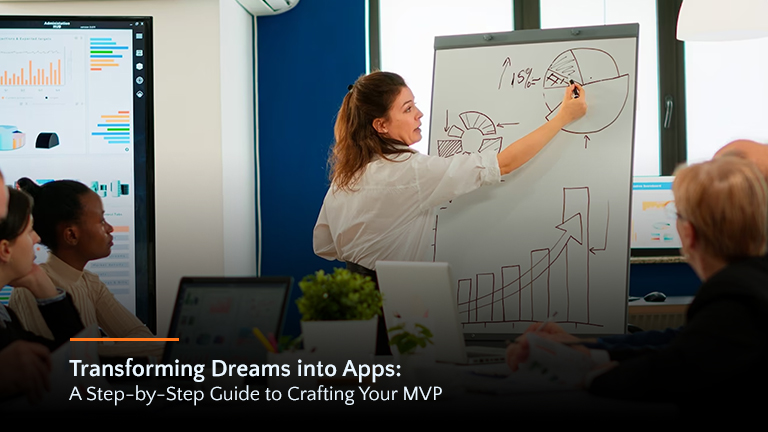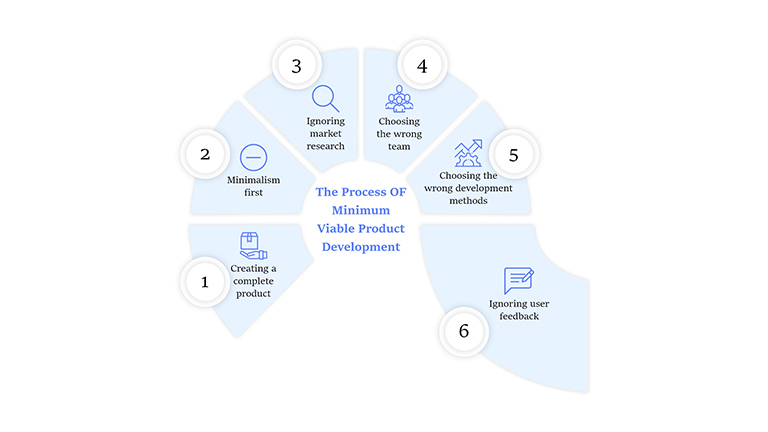Turning a fantastic idea into a fully functional product in the quickly expanding world of mobile app development can be both exhilarating and overwhelming. You have a vision for a revolutionary mobile app that has the potential to disrupt the market, but where do you start? Enter the Minimum Viable Product (MVP), a strategic cornerstone that can help you turn your idea into a reality while minimising risks and maximising results.
In this detailed guide, we’ll walk you through the process of creating an MVP for your mobile app, from concept to tangible implementation. We’ll dissect the main principles, best practises, and critical strategies that will pave the path for your app’s successful launch.
Facebook, Uber, Instagram, and Tinder are all making a fortune in their own sectors today. They have versatile apps with intuitive features and app designs to provide a more engaging user experience. However, this was not always the case. There was a period when these top platforms had few features and a crude UI/UX design.
This social media network gradually evolved over time and expanded its reach by delivering new features and functionalities via an MVP. With over 2.99 billion monthly active users, Facebook is currently one of the largest social networking networks.

The Top 4 MVP Development Advantages to Attract Investors
When seeking investment for your mobile app startup, it’s critical to present a compelling case that captures the attention of potential investors. One powerful tool in your arsenal is the Minimum Viable Product (MVP). An MVP serves as a strategic advantage, enabling you to showcase your app’s potential and viability while minimising risks.
- 1. Proof of Concept:
An MVP is a tangible representation of your app idea, demonstrating its core functionalities and value proposition. By having a working prototype, you provide solid evidence that your concept has real-world potential. Investors are more likely to be persuaded when they can see and interact with a functional product, as it validates your claims and minimizes the uncertainty associated with investing in a mere idea.
- 2. Market Validation:
Building an MVP allows you to conduct early-stage testing in the market. You can gather valuable user feedback and data, which will help you refine your app’s features and identify any potential pain points. Investors are attracted to founders who are well-informed about their target audience and have validated their assumptions through real-world usage.
- 3. Cost Efficiency:
MVP development follows a lean approach, focusing only on the essential features to bring the product to life. This cost-effective strategy is appealing to investors as it demonstrates a prudent use of resources. By starting with an MVP, you can gauge market interest without incurring significant development expenses, making it an attractive proposition for potential backers.
- 4. Speed to Market:
Time-to-market is critical in the fast-paced app industry. With an MVP, you can launch your product sooner and gain a competitive advantage. Investors are more likely to be enticed by a startup that can move quickly and adapt to market demands. An MVP enables you to iterate and enhance your app based on real-world user feedback, ensuring you stay ahead in the race.
Real-World Examples of Businesses that Begun with MVPs
Many successful firms today began with the creation and release of Minimum Viable Products (MVPs). These real-world examples show how the deliberate use of MVPs enabled these businesses to validate their ideas, acquire customer input, and grow into viable businesses.
Let’s look at some inspiring examples:
- 1. Airbnb: One of the most iconic examples of a company that started with an MVP is Airbnb. In 2007, the founders rented out air mattresses in their living room to attendees of a design conference in San Francisco. This simple and scrappy approach served as their MVP, validating the concept of peer-to-peer short-term lodging rentals. Today, Airbnb is a global hospitality giant with millions of listings worldwide.
- 2. Dropbox: Before becoming a cloud storage behemoth, Dropbox began as a simple video demonstrating the concept of cloud-based file sharing. Founder Drew Houston created the MVP to test the idea’s market potential. The overwhelming response to the video provided the validation needed to secure initial funding and develop the product. Dropbox now boasts millions of users and is widely regarded as one of the most successful startups in tech history.
- 3. Instagram: Instagram’s MVP was originally called “Burbn,” a location-based app that allowed users to check-in, post photos, and share their activities. After noticing that the photo-sharing feature garnered the most engagement, the founders pivoted and focused solely on that aspect, giving birth to the Instagram we know today. This MVP-driven decision proved pivotal, as Instagram became a social media powerhouse and was eventually acquired by Facebook.
- 4. Buffer: Buffer, a social media scheduling tool, started with a simple MVP that allowed users to schedule and share posts on Twitter. The founders used this MVP to gather user feedback and refine their product. As they expanded to other social media platforms based on demand, Buffer experienced significant growth and has since become a widely-used social media management platform.
How to Build an MVP?
A methodical approach and strategic planning are required to construct a basic version of your product with critical features that validate your app idea and gather user feedback. This input guarantees that your final product is refined and successful.

- 1. Define your MVP’s Goal and Scope: Begin by clearly defining the primary goal of your MVP. Identify the core problem your app will solve and the key features required to address that problem. Keep the scope minimal, focusing only on the essential functionalities needed to demonstrate your app’s value proposition.
- 2. Conduct Market Research: Thoroughly research your target market and potential competitors. Understand the pain points of your target audience and identify gaps in existing solutions. This research will help you refine your MVP’s features and positioning.
- 3. Create User Personas and User Stories: Develop user personas that represent your target audience. Outline their needs, preferences, and pain points. Use these personas to create user stories, detailing how users will interact with your app and achieve their goals.
- 4. Design the MVP: Create wireframes and mockups to visualize the user interface and user experience. Focus on simplicity and usability. Tools like Figma or Sketch can be helpful in designing the MVP’s interface.
- 5. Choose the Right Tech Stack: Select appropriate technologies and frameworks for your MVP. Consider factors like scalability, development speed, and cost-effectiveness. If you lack technical expertise, consider hiring developers or working with a development agency.
- 6. Develop the Core Features: Start building the MVP by developing the core features identified in step one. Avoid getting sidetracked by additional features that aren’t essential for the MVP’s primary goal.
- 7. Test and Iterate: Once the basic version of your MVP is ready, conduct extensive testing. Gather feedback from potential users and iterate based on their suggestions. This feedback loop is vital in refining your app and ensuring it aligns with user expectations.
- 8. Measure Metrics: Define key performance indicators (KPIs) for your MVP, such as user engagement, retention, and conversion rates. Monitor these metrics to gauge the MVP’s success and identify areas for improvement.
- 9. Launch and Gather Feedback: Release your MVP to a small group of early adopters or beta testers. Encourage them to provide feedback and insights. Their experiences will help you make data-driven decisions for the next stages of development.
- 10. Decide on the Next Steps: Based on the feedback and data collected, decide whether to pivot, persevere, or proceed to the next phase of development. Use the insights gained from the MVP to inform your app’s future roadmap.
What Does it Cost to Create an MVP?
After learning how to design an MVP, another important concern that arises in the mind of an entrepreneur is the expense of development. Even if the cost of developing an MVP is less than the whole cost of app development, it might still be expensive if the important variables are not considered.
While it is difficult to provide an exact cost without knowing your MVP’s precise requirements, an approximate estimate for a simple MVP can range from $10,000 to $50,000. However, depending on the parameters listed above, this cost can vary greatly. To receive an accurate cost estimate for your MVP, you must engage closely with the development team and have a clear grasp of your goals. Remember that investing in a well-executed MVP is a critical step towards developing a long-term successful and scalable product.
How Ndimension Labs helps to build the MVP ?
Ndimension Labs is a leading technology company that specializes in building Minimum Viable Products (MVPs) to help startups and businesses bring their app ideas to life. Here’s how Ndimension Labs can assist you in creating an MVP and the advantages of using their services:
- Expert Team of Developers and Designers: Ndimension Labs boasts a skilled and experienced team of developers, designers, and project managers who have expertise in building MVPs across various industries and domains. Their team understands the nuances of MVP development and can guide you through the entire process with efficiency and professionalism.
- Customized MVP Solutions: The team at Ndimension Labs recognizes that each app idea is unique, and one size doesn’t fit all. They work closely with clients to understand their specific requirements and tailor the MVP solution accordingly. This personalized approach ensures that your MVP is aligned with your vision and goals.
- Agile Development Methodology: Ndimension Labs follows an agile development methodology, enabling them to deliver results in iterative cycles. This approach allows for continuous feedback and flexibility, ensuring that your MVP evolves based on user insights and market demands.
- Focus on User Experience (UX) and Design: A key aspect of successful MVPs is a seamless and intuitive user experience. Ndimension Labs places great emphasis on UX design, ensuring that your MVP is user-friendly and appeals to your target audience.
- Speed to Market: Time-to-market is critical in the competitive app landscape. Ndimension Labs is known for its ability to develop MVPs efficiently and promptly, enabling you to launch your product faster and stay ahead of the competition.
- Quality Assurance and Testing: Ndimension Labs takes quality assurance seriously, conducting rigorous testing to identify and rectify any issues or bugs in the MVP. This attention to detail ensures that your MVP performs optimally and provides a positive user experience.
- Scalable Solutions: While MVPs are meant to be lean and focused, Ndimension Labs ensures that the foundation of your MVP is scalable. This way, when your app gains traction and requires further development, the transition to a full-fledged product is seamless.
- Transparent Communication and Collaboration: Ndimension Labs maintains clear and transparent communication throughout the development process. They collaborate closely with clients, keeping them informed of progress, challenges, and opportunities.
- Cost-Effective Services: Ndimension Labs offers competitive pricing for MVP development services, making it a cost-effective choice for startups and businesses looking to validate their app ideas without breaking the bank.
- Post-Launch Support and Maintenance: Beyond the development phase, Ndimension Labs provides post-launch support and maintenance services to ensure that your MVP continues to function smoothly and evolves with the changing needs of your users.
If you are still unclear about how to create an MVP that can attract investment for your firm, then contact us right away; we will gladly assist you.




